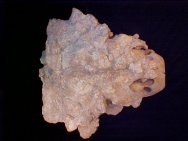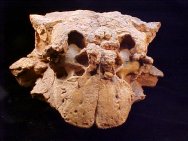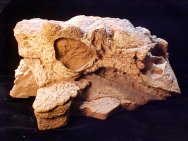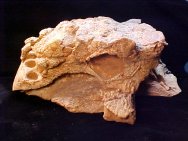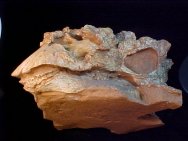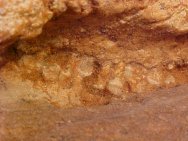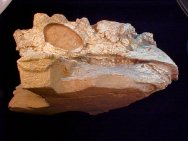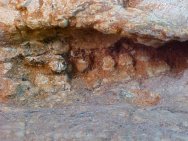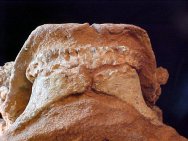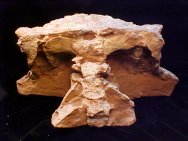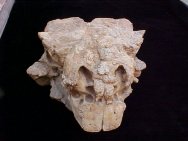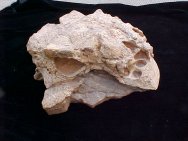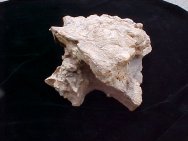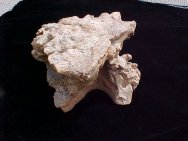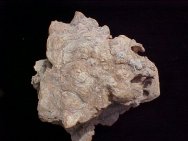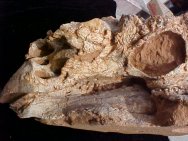Name: Pinacosaurus
grangeri Phylum
Chordata, Class Sauropsida, Superorder Dinosauria, Order Ornithischia,
Suborder Thyreophora, Infraorder Ankylosauria, Family Ankylosauridae,
Subfamily Ankylosaurinae
Geological
Time: Upper Cretaceous Campanian Stage (~83 m.y.a.)
Size: The
width of the skull is 12 1/2", depth is 6" and the length is
12 1/2" including the vertebrae (10 1/2" without vertebrae).
Fossil Site:
Bayan Mandahu (= Djadochta) Formation, Bayn Dzak, Gobi Desert of Mongolia
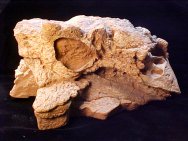 This
is the well-preserved skull of an armored dinosaur known as Pinacosaurus
grangeri from the famous Bayan Mandahu location in the Gobi that
was initially discovered by Charles Gilmore in 1933. Gilmore was
a member of the famous Central Asiatic Expeditions to the Gobi led
by Roy Chapman Andrews in the 1920’s. Bayn Dzak is the most
famous of all locations, and was termed the Flaming Cliffs by Andrews.
Gilmore originally placed the badly crushed skull and scattered
other material he found in the Nodosauridae, but Pinacosaurus was
subsequently found to be a member of the Ankylosauridae. At 5 meters
in overall length, Pinacosaurus was a medium-sized ankylosaur which
shared in common with Saichania a most unusual trait: the possession
of thin curved bones similar to the respiratory turbinal bones of
mammals. They
are the only reptiles positively known to possess these structures
that were thought to warm, filter, and moisten incoming air. This
is the well-preserved skull of an armored dinosaur known as Pinacosaurus
grangeri from the famous Bayan Mandahu location in the Gobi that
was initially discovered by Charles Gilmore in 1933. Gilmore was
a member of the famous Central Asiatic Expeditions to the Gobi led
by Roy Chapman Andrews in the 1920’s. Bayn Dzak is the most
famous of all locations, and was termed the Flaming Cliffs by Andrews.
Gilmore originally placed the badly crushed skull and scattered
other material he found in the Nodosauridae, but Pinacosaurus was
subsequently found to be a member of the Ankylosauridae. At 5 meters
in overall length, Pinacosaurus was a medium-sized ankylosaur which
shared in common with Saichania a most unusual trait: the possession
of thin curved bones similar to the respiratory turbinal bones of
mammals. They
are the only reptiles positively known to possess these structures
that were thought to warm, filter, and moisten incoming air.
While
most ankylosaurs are thought to have been solitary animals, a discovery
of several juvenile specimens announced by a joint Chinese-Canadian
expedition to the Gobi in 1988 suggested that the sheep-sized babies
might have been smothered during a sandstorm. While several specimens
are known that range in size from adult to juvenile, very little
well-preserved adult cranial material is known, making this a most
exceptional specimen of undoubted museum quality.
Although
skeletal bones of Pinacosaurus are relatively common at the site,
this is one of only two known adult skulls of diagnostic quality,
and is a most majestic and valuable specimen. The Djadokhta Formation
of Mongolia from which the specimen comes yielded the first undoubted
dinosaur eggs, Protoceratops, Velociraptor and many other theropods.
In addition, many examples of turtles, crocodiles, lizards and mammals
have been discovered.
The
specimen has no restoration and is essentially unprepared. The
pictures below provide many perspectives (or lighting) of this unique
Cretaceous dinosaur fossil.
|
|


